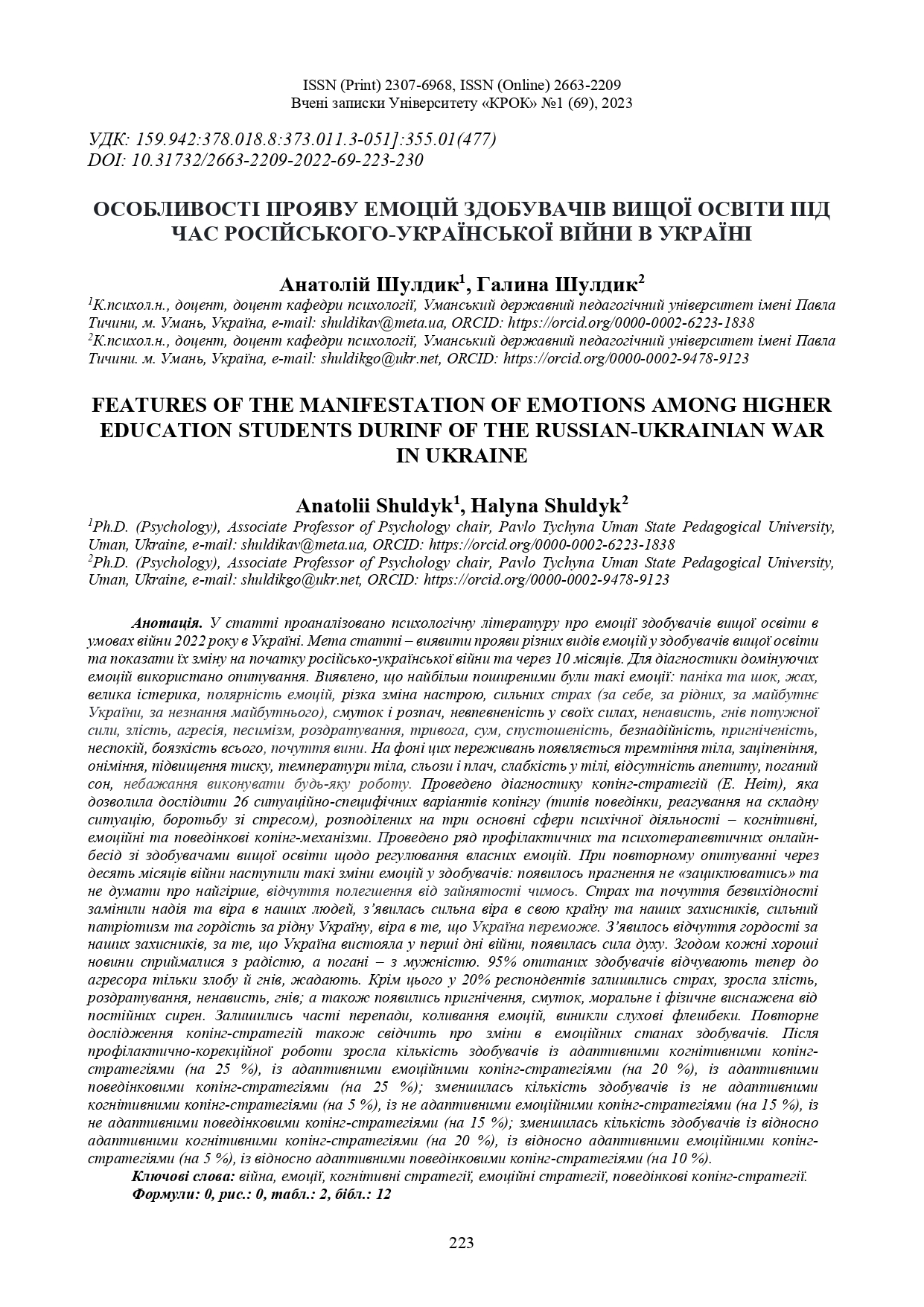ОСОБЛИВОСТІ ПРОЯВУ ЕМОЦІЙ ЗДОБУВАЧІВ ВИЩОЇ ОСВІТИ ПІД ЧАС РОСІЙСЬКОГО-УКРАЇНСЬКОЇ ВІЙНИ В УКРАЇНІ
DOI:
https://doi.org/10.31732/2663-2209-2022-69-223-230Ключові слова:
війна, емоції, когнітивні стратегії, емоційні стратегії, поведінкові копінг-стратегіїАнотація
У статті проаналізовано психологічну літературу про емоції здобувачів вищої освіти в умовах війни 2022 року в Україні.
Мета статті – виявити прояви різних видів емоцій у здобувачів вищої освіти та показати їх зміну на початку російсько-української війни та через 10 місяців.
Для діагностики домінуючих емоцій використано опитування. Виявлено, що найбільш поширеними були такі емоції: паніка та шок, жах, велика істерика, полярність емоцій, різка зміна настрою, сильних страх (за себе, за рідних, за майбутнє України, за незнання майбутнього), смуток і розпач, невпевненість у своїх силах, ненависть, гнів потужної сили, злість, агресія, песимізм, роздратування, тривога, сум, спустошеність, безнадійність, пригніченість, неспокій, боязкість всього, почуття вини. На фоні цих переживань появляється тремтіння тіла, заціпеніння, оніміння, підвищення тиску, температури тіла, сльози і плач, слабкість у тілі, відсутність апетиту, поганий сон, небажання виконувати будь-яку роботу.
Проведено діагностику копінг-стратегій (E. Heim), яка дозволила дослідити 26 ситуаційно-специфічних варіантів копінгу (типів поведінки, реагування на складну ситуацію, боротьбу зі стресом), розподілених на три основні сфери психічної діяльності – когнітивні, емоційні та поведінкові копінг-механізми.
Проведено ряд профілактичних та психотерапевтичних онлайн-бесід зі здобувачами вищої освіти щодо регулювання власних емоцій.
При повторному опитуванні через десять місяців війни наступили такі зміни емоцій у здобувачів: появилось прагнення не «зациклюватись» та не думати про найгірше, відчуття полегшення від зайнятості чимось.
Страх та почуття безвихідності замінили надія та віра в наших людей, з’явилась сильна віра в свою країну та наших захисників, сильний патріотизм та гордість за рідну Україну, віра в те, що Україна переможе. З’явилось відчуття гордості за наших захисників, за те, що Україна вистояла у перші дні війни, появилась сила духу. Згодом кожні хороші новини сприймалися з радістю, а погані – з мужністю. 95% опитаних здобувачів відчувають тепер до агресора тільки злобу й гнів, жадають. Крім цього у 20% респондентів залишились страх, зросла злість, роздратування, ненависть, гнів; а також появились пригнічення, смуток, моральне і фізичне виснажена від постійних сирен. Залишились часті перепади, коливання емоцій, виникли слухові флешбеки.
Повторне дослідження копінг-стратегій також свідчить про зміни в емоційних станах здобувачів. Після профілактично-корекційної роботи зросла кількість здобувачів із адаптивними когнітивними копінг-стратегіями (на 25 %), із адаптивними емоційними копінг-стратегіями (на 20 %), із адаптивними поведінковими копінг-стратегіями (на 25 %); зменшилась кількість здобувачів із не адаптивними когнітивними копінг-стратегіями (на 5 %), із не адаптивними емоційними копінг-стратегіями (на 15 %), із не адаптивними поведінковими копінг-стратегіями (на 15 %); зменшилась кількість здобувачів із відносно адаптивними когнітивними копінг-стратегіями (на 20 %), із відносно адаптивними емоційними копінг-стратегіями (на 5 %), із відносно адаптивними поведінковими копінг-стратегіями (на 10 %).
Завантаження
Посилання
Ліхі Р. Л. Теорія емоційних схем. Відмінні особливості / пер. з анг. К. : Диалектика, 2021. 162 с.
Ралітна Ю. О., Сингаївська І. В. Негативні психічні стани особистості в кризових життєвих ситуаціях. Держава, регіони, підприємництво: інформаційні, суспільно-правові, соціально-економічні аспекти розвитку : тези доповідей ІІІ Міжнародної конференції (Київ, 02 грудня 2021 р.). К. : Університет КРОК, 2021. URL: https://conf.krok.edu.ua/SRE/SRE-2021/paper/view/870
Чудаєва Н. В., Шулдик Г. О. Емоційний світ людини. 2-ге вид. доповн. Умань, 2017. 126 с.
Шулдик А. В., Шулдик Г. О. Психологія емоцій : навч.-метод. посібник. Умань : ВПЦ Візаві, 2023. 161 с.
Bernsten D. & Rubin, D. Emotionally Charged Autobiographical Memories Across the Life Span: The Recall of Happy, Sad, Traumatic, and Involuntary Memories. Psychology and Aging. 2002. No. 17(4). P. 636–652.
Bessel van der Kolk. The Body Keeps the Score. 2015. 464 p.
Deb Dana (2020) Polyvagal Exercises for Safety and Connection: 50 Client-Centered Practices.
Lisa Feldman Barrett (2017) How Emotions are Made: The Secret Life of the Brain. Houghton Mifflin Harcourt.
Panksepp, J., and Davis, K. (2018). The Emotional Foundations of Personality: A Neurobiological and Evolutionary Approach. New York: W. W. Norton & Company.
Porges SW (2021). Polyvagal Safety: Attachment, Communication, Self-Regulation. New York: W. W. Norton & Company.
Robert L. Leahy (2019) Emotional Schema Therapy: Distinctive Features.
Johnson, S.M. (2019) Attachment Theory in Practice: Emotionally Focused Therapy (EFT) With Individuals, Couples, and Families. New York: Guilford Press.

Downloads
Опубліковано
Як цитувати
Номер
Розділ
Ліцензія

Ця робота ліцензується відповідно до Creative Commons Attribution-NonCommercial 4.0 International License.

